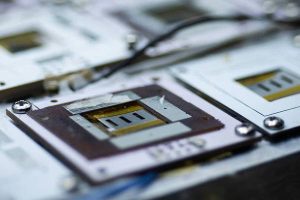 Princeton University is predicting five years, and maybe 30 years, of outdoor life from a Perovskite solar cell stack-up invented in its labs.
Princeton University is predicting five years, and maybe 30 years, of outdoor life from a Perovskite solar cell stack-up invented in its labs.
The key is a 2D material barrier layer between the photon-absorbing perovskite layer and the hole transport layer.
“While the idea of a 2D capping layer isn’t new, it is still considered an emerging technique,” according to the University.
The cells are fully inorganic, with a caesium lead tri-iodide (CsPbI3) absorber and a copper thiocyanate hole-transport.
Researcher Xiaoming Zhao and colleagues were building and testing “scores of permutations” of layer chemistries and geometries, said Princeton, to optimise light absorption while protecting the fragile parts of the stack from deterioration.
They found that a two-dimensional Cs2PbI2Cl2 layer not only stabilised the absorber/hole-transport interface, pushing up life, but also boosted conversion efficiency from 14.9 to 17.4%.
“There was basically zero [efficiency] drop after nearly half a year,” said Zhao.
At the same time, the lab was looking for a realistic accelerated life test, choosing heat, humidity and light exposure as accelerators.
Samples were soaked at four different temperatures up to 110°C
Devices with the 2D layer did not degrade at 35°C, according to a paper published on them in Science (see below), and would sustain 80% of initial efficiency after over 2,100 hours at 110°C under constant illumination.
Arrhenius temperature dependence was observed, said the paper, and was used to predict intrinsic lifetime of 51,000 ±7,000hours (nearly six years) if operated continuously at 35°C.
That is the lab equivalent of 30 years of outdoor operation in an area like Princeton, according to fellow researcher Professor Lynn Loo.
“We might have the record today, but someone else is going to come along with a better record tomorrow,” she said, “The really exciting thing is that we now have a way to test these devices and know how they will perform in the long term.”
The inorganic nature of the materials and the barrier layer are not the only reasons this cell survives so well: its perovskite is prepared as a particular nano-crystalline film known to resist change at elevated temperatures, and it also has two more life-extending thin layers, as well as heavily-encapsulation.
In detail, it was built up on a front-glass with a fluorine-doped tin-oxide electrode coating.
On to this was first deposited a titanium dioxide electron transport layer, and then, before the perovskite, another interface stabiliser – a layer of aluminium oxide. After this came the perovskite photon absorber, the 2D barrier, the copper hole-transport, then a life-boosting chromium anti-diffusion layer, followed by the gold back electrode.
To protect this assembly from the rear, a coating of PMMA was applied, then a second protective coating of Cytop amorphous fluoropolymer. Finally, the cell was closed from the rear with another glass sheet, which was edge-sealed to the front glass using epoxy.
The team’s paper in Science is ‘Accelerated aging of all-inorganic, interface-stabilized perovskite solar cells‘.
“This paper is likely going to be a prototype for anyone looking to analyse performance at the intersection of efficiency and stability,” said US National Renewable Energy Laboratory solar cell physicist Joseph Berry. “By producing a prototype to study stability, and showing what can be extrapolated, it’s doing the work everyone wants to see before we start field testing at scale. It allows you to project in a way that’s really impressive.”
“Some people are still going to want to see it play out,” he added, “But this is much more credible science than a lot of other attempts at forecasting.”
Princeton worked with Linköping University in Sweden
Photo: Bumper DeJesus, Princeton University
